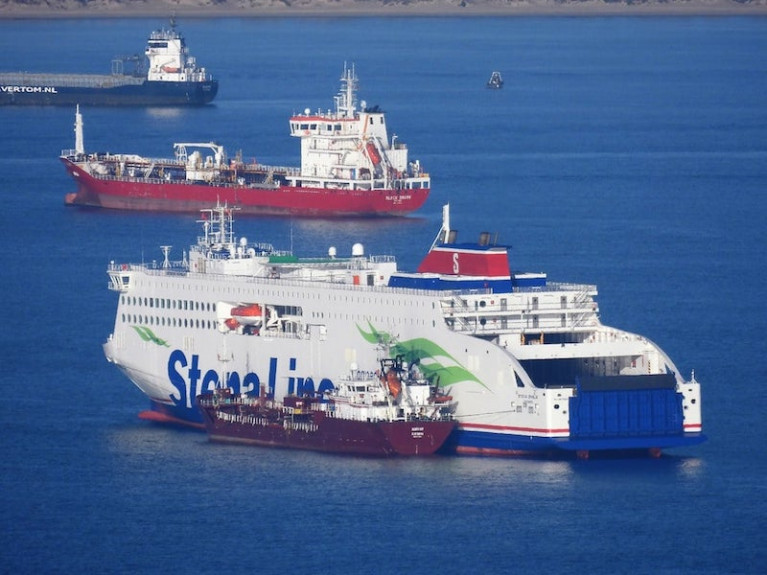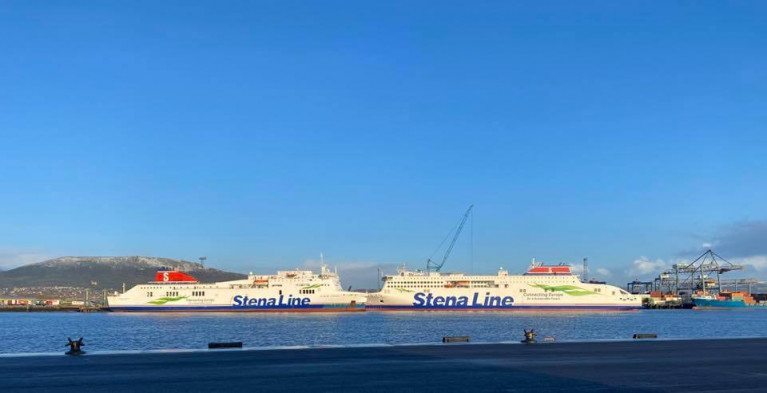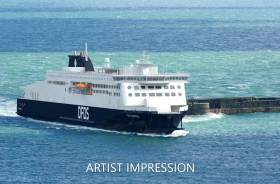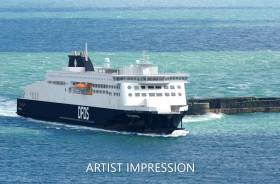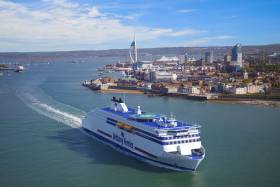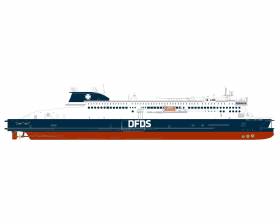Displaying items by tag: Stena EFlexer
New Stena 'E-Flexer' Ropax Makes Delivery Voyage Completing Trio for Irish Sea Service
Stena Embla the latest Chinese newbuild 'E-Flexer' class ropax completed a month-long delivery voyage to Europe where the ferry is to join sisters on the Irish Sea, writes Jehan Ashmore.
The 40,050 gross tonnage newbuild built in Weihai, was tracked by Afloat.ie on the evening of New Year's Day in the Celtic Sea heading into the Irish Sea bound for Holyhead, Wales to where a brief call was made in the early hours of the next day before proceeding to Belfast Harbour. The new ferry berthed at the port's VT2 terminal.
The last port of call during Stena Embla's long delivery voyage was the southern Spanish port of Algerciras, opposite of Gibraltar, having called previously via Singapore, Sri Lanka and then a transit of the Suez Canal.
The Spanish call was to enable 'bunkers' transferred from a small tanker. On a related note, at the same time Stena Embla was tracked in the Celtic Sea, another tanker, Lizrix from Falmouth, was anchored off Rosslare Europort prior to entering the Wexford port to refuel Stena Horizon serving on the Cherbourg route.
The French service was recently boosted in freight capacity as the ro-ro Stena Foreteller took up service before Christmas which was earlier than planned to tomorrow's original start-up date. This was due to a major surge in demand from hauliers to arrive in mainland Europe and avoid customs checks of a post-Brexit UK.
While there is much attention to yesterday's newest 'Brexit-buster' route to Dunkirk operated by DFDS, Stena will introduce Stena Embla as the second E-Flexer on the Irish Sea between Belfast and Birkenhead (Liverpool). The new ferry has a capacity for 1,000 passengers, 120 cars and 3,100 lane metres of freight.
The other E-Flexer is Stena Edda along with Stena Mersey currently operates the 8 hour route. Each of the E-Flexers, have 40% more deck capacity, 40% more cabins and 30% more fuel-efficient than the Stena Mersey which will be replaced by the newbuild.
Stena Mersey along with former fleetmate and sister Stena Lagan (lenghtened last year to increase freight capacity), was in March replaced by the the E-Flexer, Stena Edda. Both of the 'river' theme named ropax vessels will be reunited when work also to enlarge Stena Mersey is due for completion next summer. At that stage, both the pair will have been renamed to reflect a deployment to a Baltic Sea route for the same operator.
As for the third E-Flexer on the Irish Sea, this is the leadship of the class Stena Estrid which entered service almost a year ago on the Dublin-Holyhead route. This winter the ferry was on relief duty between Belfast-Birkenhead but is back operating routine duties on the premier Irish Sea route.
In total Stena Ro Ro has ordered 9 of the Stena E-Flexer class and all built in China, though last year there was a change of ownership at the shipyard in Weihai.
Three of the newbuilds have been chartered to Brittany Ferries, firstly the Galicia which made a debut in December on UK-Spain service whereas DFDS will receive their E-flexer on the short-sea Dover-Calais service this year.
Brand New Stena E-Flexer Completes Maiden Delivery Voyage to Belfast Harbour
The brand new 'next generation' ropax ferry Stena Edda for the first time arrived into Belfast Harbour this morning following a 10,500 mile delivery voyage from China, writes Jehan Ashmore.
Afloat also tracked the Chinese built Stena Line E-Flexer ropax class yesterday at anchor in Belfast Lough having sailed up the Irish Sea. Following an overnight anchorage the 40,000 gross tonnage ferry made a maiden arrival in Belfast Port this morning having docked at the VT2 terminal for berthing trials.
Stena Edda is understood to enter the Belfast-Birkenhead (Liverpool) route next month and will become amongst the most environmentally sustainable vessels in the Irish Sea. At 215 metres in length, Stena Estrid is larger than today’s standard ropax vessels, with space to carry 120 cars and 1,000 passengers, and a freight capacity of 3,100 lane meters. This will be a boost to the route as there is a 50 per cent increase in freight tonnage.
Introduction of Stena Edda will also result in the direct replacement of Stena Lagan. In addition another new sister, Stena Embla is also to debut on the Irish Sea route ultimately leading in the withdrawal of the route's second ship sister, Stena Mersey.
In order to accommodate the E-Flexers, a new double tier berth linkspan has been installed in Belfast Harbour. While in Birkenhead, further adaptive works as Afloat previously reported began at the Twelve Quays River Terminal on Merseyside. The route is the longest on the Irish involving a 8-hour passage time.
Already in service on the Irish Sea is the leadship of the E-Flexer class, Stena Estrid which entered on the Dublin-Holyhead route last month.
New Ferry Delivered to Stena Expected to Be Sailing on Dublin-Holyhead Route by January
The first of five new ferries from China, Stena has received and expects to have the vessel (see: following trials) operating on the key Dublin to Holyhead route by January.
According to the Belfast Telegraph, Stena Estrid will be formally handed over at the Weihai shipyard to begin its approximately 10,000-nautical mile journey to Dublin, which will take a month.
A sister ship is expected to join the ferry company's Belfast to Liverpool service with the Stena Edda by late 2020, while the Stena Embla will start carrying passengers in 2021.
"Today has been six years in the planning," said Stena technical operations director Bjarne Koitrand.
"We are delighted to finally take ownership of the first of our five new ships.
"With the new crew now in place, they can start the long journey to the Irish Sea."
To read more click here, about the introduction 42,400-tonne ship which can carry 1,000 passengers, 210 freight vehicles and 120 cars.
Leadship of New Stena E-Flexer Class Completes Trials in China Ahead of Irish Sea Debut Next Year
Operator Stena Line has announced that the first of its three new E-Flexer class ferries destined for the Irish Sea, Stena Estrid has successfully completed sea trials in China’s Yellow Sea.
Following three days of extensive testing, the new vessel performed excellently across a wide range of stringent test criteria and is now on schedule to start operating on the Dublin to Holyhead route in early 2020 (see float-out as Afloat previously reported).
Stena Estrid is the first of five new Stena Line next generation RoPax vessels that are being constructed at the AVIC Weihai Shipyard in China, three of which will be introduced on the company’s Irish Sea routes from Dublin to Holyhead and Belfast to Liverpool.
Sister ship Stena Edda is due to enter on the Belfast-Liverpool route in spring 2020, with the third vessel Stena Embla expected to be introduced on the same route in early 2021.
Part of a multi-million pound investment in the region, the new Stena Line ships will be amongst the most advanced vessels in operation and larger than today’s standard RoPax vessels (*details below).
The sea trials are designed to ensure that all systems are fully operational and in line with strict specifications outlined by Stena Line, including areas such as engine performance and fuel consumption, navigation and radio equipment, emergency systems, speed tests, manoeuvrability, engine and thruster tests, and safety tests.
“Today the first of our five next generation ferries achieved a very important milestone” said Stena Line’s Paul Grant, Chief Commercial Officer, Irish Sea and North Sea.
“Sea trials are a critical phase in a new ship’s development, as our first opportunity to take a new vessel out to sea, put her through her paces and test that she is up to the high standards required by Stena Line.
“We systematically go through all aspects of the new ship and I am pleased to say that Stena Estrid has successfully completed every trial. We now look forward to the full handover of the vessel by the shipyard and to starting her journey to the Irish Sea,” he added.
Stena Line CEO Niclas Mårtensson said that the introduction of Stena Estrid and her sister ships reflected the company’s commitment to the Irish Sea.
“The Irish Sea is very important to Stena Line’s global business and represents a significant part of our overall revenue,” said Mr Mårtensson.
“We strongly believe that our ferry business on the Irish Sea will continue to grow and it remains a key region for the company, as evidenced by our continued investment and the addition of three new vessels, underscoring Stena Line’s commitment to our Irish Sea operations and our determination to deliver the best possible freight and travel experience to our customers.
“Stena Estrid will bring many benefits to our customers including speedy and efficient loading and unloading operations, plus further development of our Scandinavian-inspired facilities including our restful and bespoke Hygge Lounge and the latest upgrade of our premium product, the Stena Plus concept. The new ships will be spacious, light and make great use of panoramic views,” added Niclas.
“This is a very exciting time for our business and I’m proud that as Europe’s largest ferry company, Stena Line continues to shape the industry for the next generation of freight and travel customers,” he concluded.
At 215 metres in length, Stena Estrid and her sister ships for the Irish Sea will be larger than today’s standard RoPax vessels and will provide freight capacity of 3,100 lane meters and the space to carry 120 cars and 1,000 passengers and crew.
Next up for Estrid is an official handover ceremony at the shipyard before she sets sail on the long journey from China to the north Wales port of Holyhead.
STENA ESTRID FAST-FACTS
The name Estrid is connected to Stena Line’s Scandinavian heritage. It is an Old Norse eastern-Nordic version of the name Astrid. Estrid is commonly found on old runestones and means ‘divinely beautiful’.
Builder: AVIC Weihai Shipyard Co (Weihai, China)
Type: Ro-Pax ship
Ferry route / homeports: Dublin-Holyhead
Speed: 22 kn / 41 kph / 25 mph
Length (LOA): 215 m / 705 ft
Beam (width): 28 m / 92 ft
Gross Tonnage: 42400 gt
Lane Metres: 3,100
Passengers: 1000
Cars: 120
Freight vehicles: 210
Cabins: 175
Stena Line is the largest ferry operator on the Irish Sea, offering routes between Ireland and Britain including Dublin-Holyhead, Rosslare-Fishguard, Belfast-Cairnryan, and the Belfast to Liverpool and Heysham (freight only) routes. In addition a direct route to mainland Europe, Rosslare-Cherbourg with three return crossings a week.
Operator DFDS Announce Official Keel-Laying for Dover-Calais Newbuild, Cote D’Opale
Danish operator DFDS recently announced another milestone at the Avic Shipyard in Weihai, China, as the keel was officially laid on the new charter vessel, Cote D'Opale, the name which was previously reported on Afloat.ie
Owner of the newbuild Stena-E-Flexer class, Stena RoRo and DFDS will take the ferry on a 10 year bare-boat charter from delivery in China in June 2021.
Cote D'Opale will enter service on the Dover-Calais route, the busiest ferry-route between the UK and mainland Europe.
The new ferry will be the longest ship on the channel with capacity for 1,000 passengers and crew.
DFDS also operates passenger ferry services, Dover to Dunkirk, Newcastle to Amsterdam and Newhaven to Dieppe (see related story).
In addition to the UK routes, DFDS which is northern Europe’s largest integrated shipping and logistics company, they operate ferry routes in Scandinavia, the Baltic and an extensive freight-ferry network.
Danish Giant DFDS Announce Name of New English Channel Ferry for Dover Service in 2021
Danish shipping giant DFDS, has announced the name of their new ferry Côte D'Opale which is due for English Channel service between Dover and Calais in 2021.
The newbuild is named after a region of France that overlooks the English Channel. The Côte d'Opale is a French coastal region bordering Belgium, situated opposite the cliffs of the south-east of England.
Côte D'Opale yesterday started its journey with the first steel plates being cut in the traditional steel cutting ceremony. The vessel is being built at the AVIC shipyard in Weihai, China and will be launched for operation in 2021 on the Dover Calais route. It will be the longest ship on the channel with capacity for 1,000 passengers and crew.
The emphasis has been to provide customers with the best possible service and experience on board each and every day. Earlier this year DFDS put extensive investment into ensuring their ships are the best in meeting customer's needs, with investing in a substantial fleet renewal programme to ensure continued growth. Improving the customer experience with passenger comfort, children's play area, familiarity and dynamic food concepts at the forefront in the design process. Also offering WiFi, children's play area and easily accessible outdoor space.
Further development of the modern sea travel experience will be replicated over time across the fleet on the English Channel, which will bear a familiar resemblance to the Côte d'Opale. Further enhancing the best possible customer experience that DFDS has to offer, regardless of which vessel customers sail on.
Kasper Moos, Head of Short Routes and Passenger in DFDS said "We have great pleasure in announcing our new ship will be named the Cote D'Opale and the steel cutting marked a very special and exciting time as the ship starts to take shape in the construction process. The Côte D'Opale will give our passengers a relaxed travel experience with modern food concepts and the largest shopping experience on the channel. We continue to have a clear focus on our customers and take great pride in continually seeking improvements to ensure those special memorable experiences of travelling with DFDS.''
#FerryNews - Brittany Ferries has confirmed recently the charter of two brand new cruise-ferries to serve its long-haul UK to Spain routes.
Both ships adds Afloat are of the Stena E-Flexer design (see Stena Line Irish Sea debut in 2020) that will be built at the Avic International Weihai shipyard in China, with the first arriving in time for Brittany Ferries on the 2021 holiday season.
The latest investment underlines the company’s commitment to Portsmouth and to its Spanish routes. It comes after work began this spring on a brand new LNG (liquefied natural gas) cruise ferry called Honfleur to serve its most popular Portsmouth – Caen crossing. Like Honfleur, which arrives in 2019, both ships announced today will be registered under the French flag and will be crewed by French seafarers.
Together the three ships will spearhead a wide-ranging, five-year fleet-renewal and modernisation programme worth around £400m.
Portsmouth is Brittany Ferries’ UK hub and will serve as the base for both ships. Upon arrival they will cater for an ever-increasing demand for long-haul ferry travel to Spain. In 2017 the company operated 844 sailings on routes from Portsmouth, Poole and Plymouth to Santander (Cantabria) and Bilbao (Basque Country), carrying 331,000 passengers and 150,000 cars. That was around 80 per cent more than ten years earlier.
“Spain is by far the most popular foreign destination for UK holidaymakers, and we have seen significant growth in demand,” said Jean-Marc Roué, Brittany Ferries’ president. “Post-Brexit, we expect this to continue and today’s announcement is a clear statement of intent. As well as passenger traffic, we believe that an increase in freight capacity will open the door to more hauliers seeking direct access between Britain and the Iberian peninsula.”
Last year, Brittany Ferries carried around 40,000 freight units from UK to Spain. Lorry drivers are able to relax as the sea takes the strain, reducing fuel costs, tolls and road pollution that comes from driving long-haul through France.
Measuring 42,400 tonnes and 215 metres long, the new vessels will be the longest in Brittany Ferries’ fleet. If Portsmouth’s Spinnaker Tower were laid on its side, each would outstretch it by 45 metres. These impressive dimensions will allow them to carry almost two miles of freight vehicles apiece.
The new ships are being chartered from Swedish shipping company Stena RoRo, as part of its new generation of state-of-the-art ‘E-Flexer’ vessels. Both will be gas-ready and promise a combination of luxury and Spanish style. “These ships will be like twins,” added Catherine Querné, Brittany Ferries strategy director. “Outwardly, they will have the same dimensions and shape, but they will be dressed very differently. And of course each will have its own unique personality.”
There will be plenty for passengers on board. Three spacious passenger decks will host boutiques, a café, restaurant, bar and an exclusive club lounge. Around 300 en-suite cabins will cater for approximately 1,000 passengers and many will be adapted for customers with disabilities, as well as those travelling with their pet dog or cat (Brittany Ferries carries around 70,000 annually).
Elegant décor will ensure everyone feels in the holiday mood as soon as they step on board. Brittany Ferries will be working with Spanish interior designers to give the ships a stylish, modern feel and feel, evoking the golden coasts, verdant landscapes and vibrant towns of España Verde (Green Spain) on the northern coastline.
The announcement follows the launch of the first ever direct ferry service linking Ireland with Spain when Brittany Ferries’ Connemara made its first Cork-Santander sailing with an arrival to the northern Spainish port on 10 May 2018.
The year 2018 also marks 40 years of continuous services linking Britain with the Iberian Peninsula. Since 1978 more than 5.5 million passengers have enjoyed Spain without the ‘plane thanks to Brittany Ferries.
Technical specifications:
Length 214.5m
Breadth 27.8m
Draught 6.4m
Tonnage 42,400
Service speed 22 knots
Decks 10
Passengers 1,000
Passenger cabins Around 300 plus 36 for freight drivers
DFDS Charters New Ferry for Dover-Calais Service In 2021
#FerryNews - A new ferry for DFDS's Dover-Calais route will be able to carry 3,100 lane metres of cargo and 1,000 passengers. It will be built in China and deployed on the Channel in 2021.
According to DFDS, the Channel is a big and important market. Every year, five million passengers, one million cars and 1.2 million trucks travel between Dover – Calais and Dover – Dunkerque on DFDS’ ferries.
To continuously meet the customers’ demands, DFDS has decided to deploy a new ship specially designed for the services in the Channel from 2021. The ship will be built in Avic Weihai shipyard in China.
“Since the ship has not yet been built, we have great opportunities to make sure that it is designed to give our guests the best possible experience with a completely new ship. We will charter the ship from Stena RoRo and operate it for 10 years with an op-tion to buy it after that. And since we are considering replacing the fleet on the Channel in 2031, the timing is really good,” says Peder Gellert, EVP of the Shipping Division in DFDS
Four DFDS captains have been testing in simulators how to navigate the future ship to make sure that the new ship is best fitted out for the conditions on the Channel. “When sailing on the Channel, we need to ensure that the ship is at least as fast in arrival and departure situations as our current ships. Therefore, we have made modifications to increase maneuverability,” says Henrik Tidblad, Commercial Fleet Director.
The ferry will be highly efficient and environmentally friendly with an expected reduc-tion in oil consumption of around 25% compared to current ferries. It will be able to carry 3,100 lane metres of cargo and 1,000 passengers. With this capacity, it will be the largest of the ships on the Channel.
“I am really looking forward to getting this fantastic ship to boost the business on the Channel. This new ship gives us excellent opportunities to develop our business on the commercial side. A newbuild ship will give us the flexibility to make room for tax-free shopping, depending on the outcome of Brexit. Together with an architect, we will design the interior of the ship to make sure we maximise our opportunities,” says Kasper Moos, VP of Business Unit Channel in DFDS.
The initial plan is for replacement of the oldest of the ferries, Calais Seaways, which was built in 1991. Market developments will determine the final deployment plan, which will be announced in 2020.


























